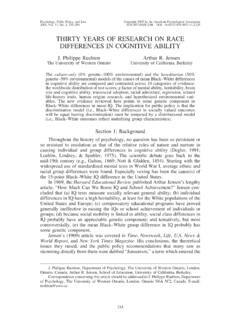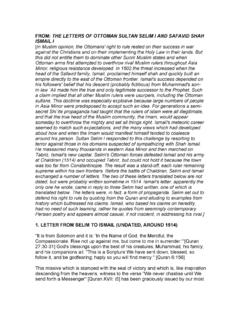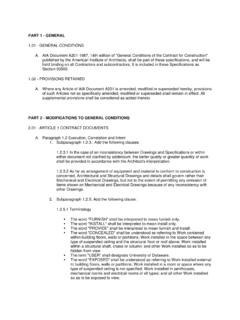Transcription of Gendered Media: The Influence of Media on Views of Gender
1 Article 7 Gendered Media :The Influence of Mediaon Views of GenderJulia T. WoodDepartment of Communication, University of NorthCarolina at Chapel HillTHEMES IN MEDIAOf the many influences on how we view men andwomen, Media are the most pervasive and one of themost powerful. Woven throughout our daily lives, mediainsinuate their messages into our consciousness at everyturn. All forms of Media communicate images of thesexes, many of which perpetuate unrealistic, stereotypi-cal, and limiting perceptions. Three themes describe howmedia represent Gender . First, women are underrepre-sented, which falsely implies that men are the culturalstandard and women are unimportant or invisible.
2 Sec-ond, men and women are portrayed in stereotypicalways that reflect and sustain socially endorsed Views ofgender. Third, depictions of relationships between menand women emphasize traditional roles and normalizeviolence against women. We will consider each of thesethemes in this of WomenA primary way in which Media distort reality is inunderrepresenting women. Whether it is prime-time tele-vision, in which there are three times as many white menas women (Basow, 1992 p. 159), or children s program-ming, in which males outnumber females by two to one,or newscasts, in which women make up 16% of news-casters and in which stories about men are included 10times more often than ones about women ( Study Re-ports Sex Bias, 1989), Media misrepresent actual pro-portions of men and women in the population.
3 Thisconstant distortion tempts us to believe that there reallyare more men than women and, further, that men arethe cultural S MISREPRESENTATION OFAMERICAN LIFEThe Media present a distorted version of cultural lifein our country. According to Media portrayals:White males make up two-thirds of the popula-tion. The women are less in number, perhaps be-cause fewer than 10% live beyond 35. Those whodo, like their younger and male counterparts, arenearly all white and heterosexual. In addition tobeing young, the majority of women are beauti-ful, very thin, passive, and primarily concernedwith relationships and getting rings out of collarsand commodes.
4 There are a few bad, bitchywomen, and they are not so pretty, not so subor-dinate, and not so caring as the good of the bad ones work outside of the home,which is probably why they are hardened and un-desirable. The more powerful, ambitious men oc-cupy themselves with important business deals,exciting adventures, and rescuing dependent fe-males, whom they often then assault Gendered Lives: Communication, Gender , and Culture by Julie T. Wood, Chapter 9, pp. 231-244. 0 1994. Reprinted withpermission of Wadsworth Publishing, a division of Thomson Learning.
5 Fax LI Y IIYC~ WI I H MEDIAO ther myths about what is standard are similarly for-tified by communication in Media . Minorities are evenless visible than women, with African-Americans ap-pearing only rarely (Gray, 1986; Stroman, 1989) and otherethnic minorities being virtually nonexistent. In chil-dren s programming when African-Americans do ap-pear, almost invariably they appear in supporting rolesrather than as main characters (O Connor, 1989). Whilemore African-Americans are appearing in prime-timetelevision, they are too often cast in stereotypical the 1992 season, for instance, 12 of the 74 series oncommercial networks included large African-Americancasts, yet most featured them in stereotypical roles.
6 Blackmen are presented as lazy and unable to handle author-ity as lecherous, and/or as unlawful, while females areportrayed as domineering or as sex objects ( SightsSounds, and Stereotypes, 1992). Writing in 1993, DavidEvans (1993, p. 10) criticized television for stereotypingblack males as athletes and entertainers. These roleswrote Evans, mislead young black male viewers in&thinking success is only a dribble or dance step away and blind them to other, more realistic ambitions. l&-panics and Asians are nearly absent, and when they arepresented it is usually as villains or criminals (Lichter,Lichter, Rothman, & Amundson, 1987).
7 Also under-represented is the single fastest growinggroup of Americans- older people. As a country, we areaging so that people over 60 make up a major part ofour population; within this group, women significantlyoutnumber men (Wood, 1993~). Older people not onlyare under-represented in Media but also are repre-sented inaccurately In contrast to demographic reali-ties, Media consistently show fewer older women thanmen, presumably because our culture worships youthand beauty in women. Further, elderly individuals arefrequently portrayed as sick, dependent, fumbling andpassive, images not borne out in real life.
8 Distirteddepictions of older people and especially older womenin Media , however, can delude us into thinking theyare a small, sickly, and unimportant part of lack of women in the Media is paralleled by thescarcity of women in charge of Media . Only about 5% oftelevision writers, executives, and producers are women(Lichter, Lichter, & Rothman, 1986). Ironically, while two-thirds of journalism graduates are women, they make upless than 2% of thosepapers andin corporate management of news-only about 5% of newspaper publishers( Women in Media , 1988). Female film directors areeven rnonz-scarce, as are executives in charge of MTV Itis probably not coincidental that so few women are be-hind the scenes of an industry that so consistently por-trays women negatively Some Media analysts (Mills1988) believe that if more women had positions o;authority at executive levels, Media would offer morepositive portrayals of Portrayals of Women and MenIn general, Media continue to present both womenand men in stereotyped ways that limit our perceptionsof human possibilities.
9 Typically men are portrayed asactive, adventurous, powerful, sexually aggressive andlargely uninvolved in human relationships. Just as con-sistent with cultural Views of Gender are depictions ofwomen as sex objects who are usually young, thin beau-tiful, passive, dependent, and often incompetent anddumb. Female characters devote their primary energiesto improving their appearances and taking care of homesand people. Because Media pervade our lives, the waysthey misrepresent genders may distort how we see our-selves and what we perceive as normal and desirable formen and portrayals of men.
10 According to J. (1989, p. ill), whose research focuses on mascu-linity children s television typically shows males as ag-gressive, dominant, and engaged in exciting activitiesfrom which they receive rewards from others for their masculine accomplishments. Relatedly, recent studiesreveal that the majority of men on prime-time televisionare independent, aggressive, and in charge (McCauleyThangavelu, & Rozin, 1988). Television programming foiall ages disproportionately depicts men as serious con-fident, competent, powerful, and in high-status posi-tions. Gentleness in men, which was briefly evident inthe 197Os, has receded as established male characters areredrawn to be more tough and distanced from others(Bayer, 1986).













